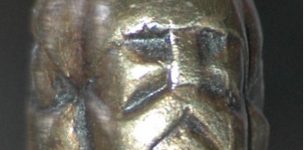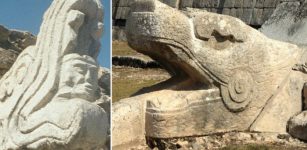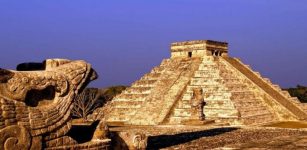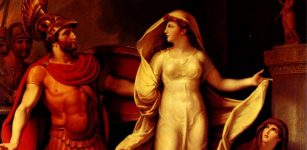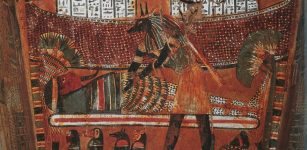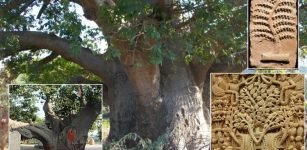Hidden Role Of The Milky Way And Egyptian Goddess Nut Examined
Conny Waters - AncientPages.com - Astronomy played a significant role in the lives of ancient Egyptians. This is evident in Egyptian mythology, which contains many references to celestial bodies such as the Sun, Moon, planets, and stars. The ancient Egyptians were renowned for their religious beliefs and profound astronomical knowledge. Still, up until now, it has been unclear what role the Milky Way played in Egyptian religion and culture.
The sky goddess Nut, covered in stars, is held aloft by her father, Shu, and is arched over Geb, her brother the Earth god. On the left, the rising sun (the falcon-headed god Re) sails up Nut’s legs. On the right, the setting sun sails down her arms towards the outstretched arms of Osiris, who will regenerate the sun in the netherworld during the night. Credit: E. A. Wallis Budge, The Gods of the Egyptians, Vol. 2 (Methuen & Co., 1904).
Recent research conducted by an astrophysicist from the University of Portsmouth sheds light on the connection between our galaxy, the Milky Way, and Nut, an Egyptian sky-goddess.
Nut is traditionally represented as a woman adorned with stars, arched over her sibling Geb, the god of Earth. She is believed to shield the earth from potential floods caused by invading void waters.
Nut played also a significant role in the daily solar cycle. It was perceived that she would swallow the sun as it set in the west. Throughout the night, it was believed that the sun journeyed through Nut's body, which was frequently associated with the underworld during this time. As dawn arrived in the east, Nut was thought to bring forth a new day by giving birth to the sun again.
Egyptologists have been facing challenges in aligning the representation of Nut, the ancient Egyptian sky goddess, with the Milky Way. This task is similar to how astronomy historians map ancient Egyptian constellations onto modern ones (for instance, our Big Dipper corresponds to their Bull’s Foreleg).
The Milky Way. Credit: Pixabay - Public Domain
The main point focused on determining whether Nut's head aligns with the section of the Milky Way that Gemini covers and her lower body corresponds to Cygnus. Alternatively, could her arms be extending towards Cygnus? These are questions that remain open for interpretation and further study.
The new research paper utilizes ancient Egyptian scriptures and modern simulations to suggest that the Milky Way may have illuminated Nut's significance as the sky deity. It theorizes that during winter, the Milky Way highlighted Nut's outstretched arms, while in summer, it traced her backbone across the heavens.
Dr. Or Graur, an Associate Professor of Astronomy, conducted a comprehensive study using various ancient resources such as the Pyramid Texts, Coffin Texts, and the Book of Nut. Comparing these texts and running advanced simulations of the Egyptian night sky, he found convincing evidence that the Milky Way was seen as an embodiment of Nut's divine presence.
"I’m an astrophysicist, not an Egyptologist. But while writing a chapter on the Milky Way for a new book on galaxies, I stumbled across the image of Nut and showed it to my daughters. They were entranced by the story of the sky goddess and the daily birth of the sun. I realized there was a bewitching power to this story and its visual depiction. But was Nut truly the Milky Way, as some authorities suspected? Or was the link between the two nothing more than wishful thinking, a thrilling idea allowed to run wild with no concrete evidence to ground it? If I wanted to include Nut in my book, I had to find out," Dr. Graur said.
Dr. Graur established connections between Egyptian cosmological beliefs and those from other cultures. His research highlighted commonalities in how various societies perceive and interpret the Milky Way.
Ancient Egyptians believed in the afterlife and considered death a transition to another reality.

The sky goddess Nut and human figures representing stars and constellations from the star chart in the tomb of Ramses VI. Credit: Hans Bernhard - CC BY-SA 3.0
"My study also shows that Nut’s role in the transition of the deceased to the afterlife and her connection to the annual bird migration are consistent with how other cultures understand the Milky Way. For example, as a spirits' road among different peoples in North and Central America or as the Birds' Path in Finland and the Baltics.
My research shows how combining disciplines can offer new insights into ancient beliefs, and it highlights how astronomy connects humanity across cultures, geography, and time. This paper is an exciting start to a larger project to catalogue and study the multicultural mythology of the Milky Way, Dr said.
The study is published in the Journal of Astronomical History and Heritage
Written by Conny Waters - AncientPages.com Staff Writer












